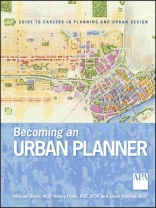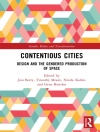Becoming an URBAN PLANNER
Are you considering a career in urban planning? Becoming an Urban Planner is the best place to start. Through in-depth interviews with more than eighty urban planners across the United States and Canada, this book gives you a valuable insider’s look at your future profession as it is lived and practiced.
Becoming an Urban Planner introduces you to the urban planning profession—its history, what you must know to prepare for a career in planning, and the different types of planning jobs. Beyond the basics, though, it shows you the realities of what it’s really like to be a planner today. You’ll learn about:
- The skills you’ll need and how to hone them in school and on the job
- Potential career paths and what people in these positions do
- Using internships, job shadowing, and other opportunities to break into the field
- Deciding among planning specialties and moving between public and private sectors
- How to search for and get your first position
- Emerging areas in planning, including sustainability and climate change
Each topic is explored through in-depth interviews with both generalists and others who have devoted their careers to a particular aspect of planning. These professionals share their insights and describe how they have arrived at where they are and how beginners like you can learn from their experiences.
With the information from this book to guide and inspire you, you will be able to chart your own path to success as an urban planner.
قائمة المحتويات
About The Authors xi
Preface xii
Acknowledgments xiv
1 Becoming an Urban Planner: What Planners Do 1
Employment in Planning 3
A Young Profession: Planning Emerges in the Late Nineteenth Century 5
An Age of Idealism in Design 6
The Advent of Zoning 9
Policy Planning Emerges Simultaneously 10
Planning and Social Injustice 11
Planning In the Late Twentieth Century 12
Urban Planning Is about the Future 13
Urban Planning Is about Place 14
Urban Planning Is about Helping Other People Make Decisions 17
The Planning Process 18
Profile: Getting People Involved in the Process 19
Buyer Beware: Things You Might Not Like About a Career in Planning 23
What Kind of Salary Can a Planner Expect to Make? 25
Skills for Becoming an Urban Planner 26
2 Becoming an Urban Planner: Education 31
What Research Shows About Plannersʼ Education 31
Preparing for a Professional Education 32
Communicating in Words 42
Communicating through Pictures 45
Being Comfortable with Numbers 50
Drawing, Planning, and Urban Design 54
Picking a College Major 60
And on to Graduate School 63
Choosing the Right Graduate Program 65
Accreditation 69
What’s In A Name? 70
Theses, Projects or other Capstone Requirements 70
Applying to Graduate School 70
Financing a Planning Education 73
Planning Curriculum: Knowledge, Skills, and Values 74
Specializations 78
Dual-Degree Options 78
Alternative Paths 79
Public Administration 79
Urban Studies 80
Economics 81
Architecture, Landscape
Architecture, and urban
Design 81
Civil Engineering 81
Planning Law 82
Profile: Becoming a Land Use Lawyer 84
Conclusion 85
3 Becoming an Urban Planner: Experience 87
Informational Interviews 88
Job Shadowing 89
Volunteer Experience 90
Internships 92
Cooperative Education 94
Peace Corps and Ameri Corps VISTA 94
Networking to Break the Ice 96
Career Ladders: Moving Ahead From That First Job 97
4 Planners’ Many Paths 99
Many Paths into a Planning Career 99
Profile: Entering the Field 100
Profile: Using Your Analytic and Creative Talents 102
Profile: Applying a Talent for Mapping 104
Who Influenced You? 109
Where Do You Want to Work? 117
Profile: Becoming a Developer 119
Profile: Becoming a Small Town Planner 122
Profile: Establishing a One-Person Planning Firm 124
Profile: Making Transitions 127
Planning Timeframes 131
Current Planning 131
Profile: Enforcing Codes and Reviewing Plans 133
Profile: Addressing the Challenges of Long-Range Planning 136
Profile: Improving Quality of Life in the Long Term 138
Profile: Creating Comprehensive Plans 140
At What Geographic Scale Do You Want to Work? 144
Profile: Working with Communities 145
Profile: Bridging Rural and Urban Areas 148
Profile: Planning in a Midsized City 150
Profile: Becoming a Planning Director 153
Profile: Charting Another Path to Planning Director 159
Profile: Merging Regional and Local Planning 164
Profile: Planning at the Regional Scale 167
Profile: Planning at the State Level 170
Profile: Leading a State Planning Agency 173
Profile: Planning in the Federal Government 175
Profile: Consulting for the Federal Government 178
What Planning Topics Interest You? 179
Urban Design 179
Profile: Designing Places 181
Profile: Using Urban Design to Create Consensus 185
Housing Planning and Policy 189
Profile: Filling Housing Needs 190
Economic Development Planning 193
Profile: Planning for Economic Development: Public Sector 195
Profile: Planning for Economic Development: Consulting 198
Historic Preservation Planning 200
Profile: Protecting, Preserving, and Planning for Historic and Cultural Resources 202
Community Engagement and Empowerment 205
Profile: Engaging Neighborhoods 208
Profile: Listening to People 211
Environmental and Natural Resources Planning 216
Profile: Advocating for Sustainability 219
Profile: Specializing in a Holistic Way 221
Geographic Information Systems 222
Profile: Specializing in GIS 223
Land use Planning, Law, And Code Enforcement 225
Profile: Bridging Technical Disciplines 227
Profile: Specializing in Code Writing 231
Profile: Specializing in Land Use Law 232
Profile: Assessing the Economic Impacts of Land Use Decisions 234
Transportation Planning 238
Profile: Developing Transportation Models 239
Profile: Planning for Transit 243
Profile: Advocating for Transit and Transportation Improvements 245
Profile: Integrating Land Use and Transportation 247
Planning For Sustainability 250
New Urbanism 252
Profile: Applying the Principles of New Urbanism 253
Profile: Fostering Transit-Oriented Development 256
Profile: Creating Change and Livable Communities 260
Profile: Planning for Bicyclists and Pedestrians 262
Emerging Specializations In The Era Of Sustainability 263
Profile: Planning for Hazards and Emergencies 264
Profile: Developing Green Communities 266
Profile: Planning for Sustainable Energy 268
Teaching Others to Become Planners 270
Profile: Becoming a Planning Professor 271
Profile: Moving from Planner to Professor 275
Profile: Being Called to a University Career̶ With a Practical Slant 279
Challenges and Rewards 281
5 What Is the Future of Planning? 293
Economic Recession and Planning 293
Profile: Coping with Layoff 294
Geospatial Technology and Planning 295
Profile: Adapting Zoning to the
Twenty-first Century 295
Rediscovering Public Health 296
Profile: Planning Healthy Communities 297
Carbon, Climate Change, Peak Oil, and Planning for Sustainable Energy 300
Planning For Climate Adaptation 301
Planning For Climate Mitigation 304
A Bright Future for Planning 306
Resources 307
References 311
Index 313
عن المؤلف
MICHAEL BAYER, AICP, is a planner with Environmental Resources Management in Annapolis, Maryland. Before becoming an urban planner, he was a newspaper reporter whose articles have appeared in the Chicago Tribune, the Milwaukee Journal Sentinel, the Journal Gazette, the Post-Bulletin, as well as Planning magazine.
NANCY FRANK, Ph D, AICP, is an associate professor and the chair of the department of urban planning at the University of Wisconsin-Milwaukee School of Architecture and Urban Planning. Frank has been instrumental in the development of the School for Urban Planning and Architecture (SUPAR), a charter Milwaukee public high school that opened in fall 2007.
JASON VALERIUS, AICP, is a planner and urban designer for MSA Professional Services, in Madison, Wisconsin. Valerius served for four years as assistant editor of the Wisconsin Chapter of the American Planning Association quarterly newsletter (WAPANews).












